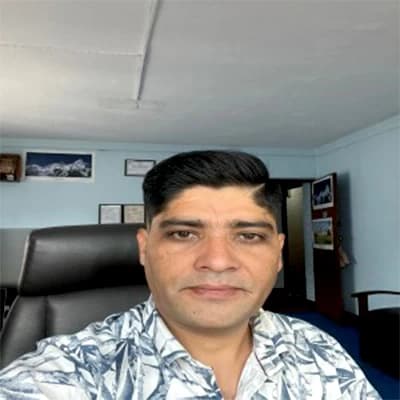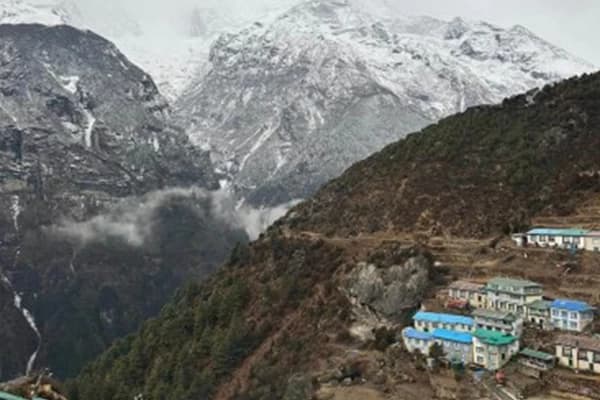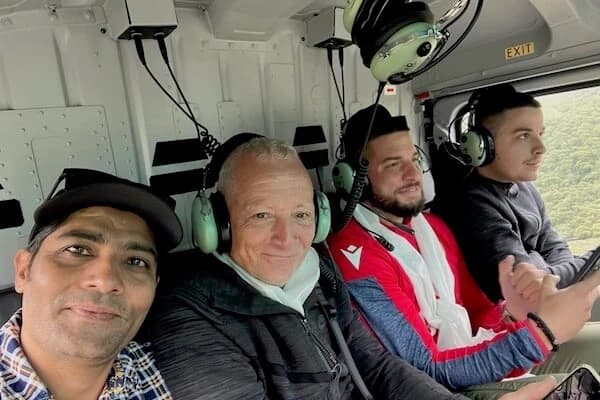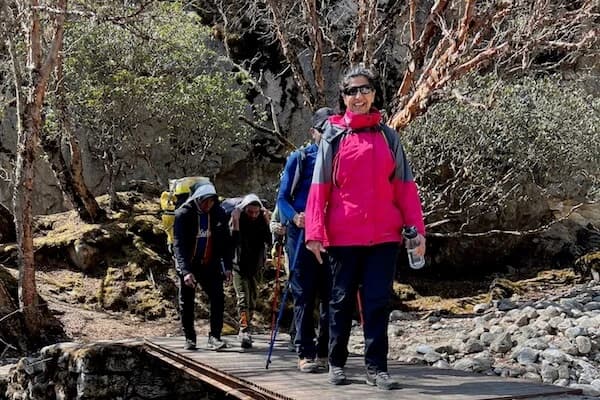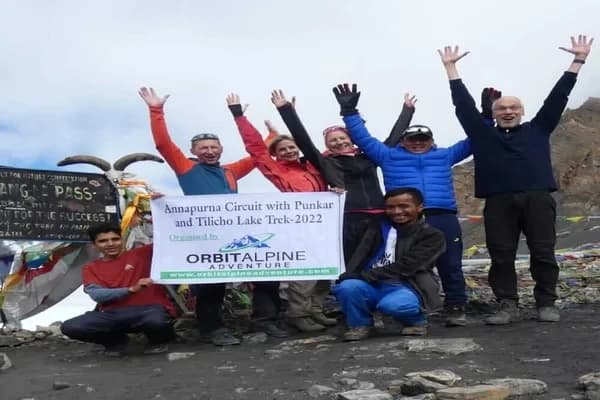It is undoubtedly one of the world's most challenging and rewarding treks. This trek introduces you to the beauty of the Khumbu region, traversing through popular high passes; Kongma La (5535m), Renjo La (5360m), and Cho La (5420m). You will get to gaze at sky-high mountains like Everest, Ama Dablam, Nuptse, Lhotse, and many other world-famous peaks.
The unique blend of high-altitude adventure, diverse landscapes, and a chance to experience the authentic Sherpa culture sets this trek apart from other treks in this region. Exploring less traveled paths, and pristine lakes, you can make your trek tranquil and have all the nature to yourself. If you want your Everest to visit more than a regular trek and want to test your endurance and physicality, the Everest three-pass trek is your ideal choice.
In this blog, we will explore every perspective of this amazing journey so that you will know what to expect and how to make your Everest trek even more exciting.
History of Everest region, Sherpa cultures and traditions
The Everest region in the country's northeastern part was isolated and remote for centuries. Sherpa people who migrated from Tibet about 500 years ago were the first to call this place home.
Its existence remained unknown until the first attempts to summit Everest were made in the 1920s by British expeditions. It boomed internationally after the first summit of Sir Edmund Hillary and Tenzing Norgay Sherpa in 1953. Then the era of Everest trekking started.
Sherpa Culture and Traditions
The Sherpas, native to the Himalayas were and are the bridge between explorers to the beauty of the Himalayas and even the summit. Known as fearless climbers around the globe also have a unique rich culture to offer the world.
Their culture and traditions are deeply connected to Tibetan Buddhism. Exploring here and there in the mountain villages, visitors can experience the beauty of ancient monasteries, prayer flags, mani walls, and ceremonies.
Sherpas have a very challenging life in the Himalayas. But it’s so beautiful to see how seamlessly they pair their hospitality, customs, and modern way of trekking and mountaineering tourism. Festivals such as Mani Rimbu offer a glimpse of their cultural and traditional heritage.
Best time to do the Everest three high pass trek
Trekking in the Everest region can be fruitful regardless of the seasons. But some trekking season is more suitable than others. This applies the most in a high-altitude trekking like this one.
So, if you want the weather conditions in your favor, pre- and post-monsoon are the best seasons for this trek.
Imagine yourself trekking on a trail guarded by Rhododendron Forest from both sides. The forest is decorated beautifully with fully bloomed and colorful wildflowers. Once you stop to take a short rest, your tiredness immediately goes away with the clear surrounding view of sky-high mountains like Everest, Ama Dablam, Nupste, Lhotse Cho Oyu, etc. The peripheral landscape is nothing like you have ever imagined or witnessed. You can feel the warmth of the weather even at this high altitude. The teahouses and trails are busy and won't give you even a second to get bored. That is how the Everest Three high pass trekking in Spring.
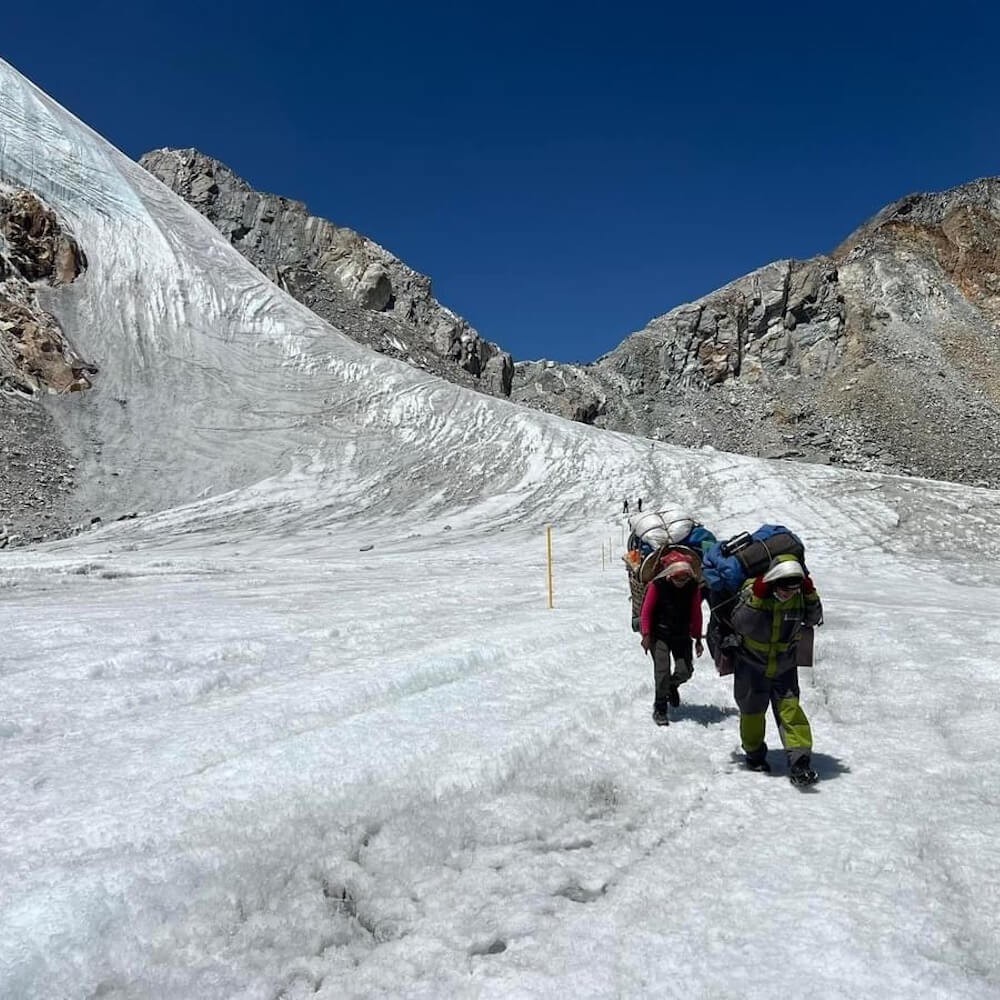
This trek is equally beautiful in Autumn too. Since this is after the monsoon season, the landscape is still wearing the green gown. That automatically makes the surrounding vistas ten times better. The temperature remains cool as the winter will be on its way making it perfect for trekking. The sky is the clearest at this time of the year. It nullifies any chance of hindrance of weather and clouds to the mountain views.
The whole nation celebrates the biggest festivals like Dashain and Tihar. So, Autumn will be the best time for you If you want to add cultural and traditional value to your Nepal visit.
But why not Winter and Summer?
Winter is quite an obvious no as during these seasons, you can always expect continuous snowfall. The trekking trails will be hard to even identify. Even if you know the trails, it would be slushy or slippery making it impossible to climb the high passes.
The same case will apply to the summer seasons too as the continuous rainfall will make it impossible to trek. Even if you are experienced and adventurous enough to trek, the lack of visibility of the surrounding views will make you feel like your trek is pointless.
Permits you need for Everest high pass trekking
There are certain permits to ensure a safe and successful Everest trekking. Permits act as a pass to enter this protected area as well as tracing you to keep data and ensure your safety.
So the different types of permits trekkers need are:
There are two options to get these permits seamlessly. Firstly, you can get it in Kathmandu at the Nepal Tourism Board Office. Or if you didn’t get it from Kathmandu and your trek has already started, you can get it in Monjo at the national park entrance gate.
Documents needed to get trekking permits in Nepal:
- Passport (Original and a Photocopy),
- Two passport-sized photos,
- Cash to pay the permit fee.
Insurance and Emergency Plans
It is always good to know your safety is ensured while embarking on this high-altitude trek. So, make sure your policy covers high-altitude trekking and emergency evacuation.
Helicopter rescues are something common in this region due to the high risk of altitude sickness and other kinds of emergencies. So, you also have to check if your insurance covers emergency helicopter evacuation and medical treatment in Nepal.
Physical fitness, training, gears & equipment, and health consideration
Physical Fitness and Training
The Everest Three High Passes trek is one of the toughest trekking routes in the Himalayas. It requires a high level of physical fitness to endure the days of walking, steep ascends and descends, and high altitudes.
So, training yourself for proper physical conditioning is super important. It plays a significant role in enhancing your trekking experience, reducing risks of injuries, and acclimatizing better.
Here are a few tips to prepare physically:
You will need a lot of stamina and endurance to bring down the difficulty of your Everest three-high pass trek from moderate to basic. So focus on cardiovascular exercises, strength training, hiking, trekking simulation, and altitude training and preparation. Start at least three months before your trek and that will play a significant role in easing your overall journey.
Cycling, jogging, and swimming are the best exercises for improving your cardiovascular strength. Likewise, squats, lunges, planks, leg raises, mountain climbers, and push-ups are great for strengthening your leg, core, and upper body muscles.

Carrying a backpack and going hiking or simulating the trek is also a great idea to be prepared for the trek. This will help you estimate your physical endurance and how much you have to work before going on the trek.
Necessary Gears and Equipment
The quality of your trekking gear is another non-negotiable factor in easing your trekking. High-quality, reliable equipment will be a lifesaver while trekking in the steep trails and cold teahouses.
Another important thing you should consider is the weight of your backpack. Trekking on high-altitude paths is already a challenging task. It will be even harder if you don’t pack right.
Packing list
- Sturdy and waterproof trekking boots, camp shoes or Sandle, trekking socks,
- Lightweight and insulated gloves, lightweight trekking pants, moisture-wicking t-shirts,
- Waterproof jacket and pants, fleece jacket, thermal tops and bottoms,
- 2 good quality trekking poles,
- Waterproof or backpack with rain cover; one for personal use and one for packing your stuff,
- Sleeping bag (rated to -20℃/-4℉), water bottle, water purification tablets/filter,
- Biodegradable soap, quick-dry towel, wet wipes, sunscreen, lip balm, sun and warm hat, sunglass, headlamp, camera, snacks(energy bars and nuts),
- Personal medications, painkillers, antiseptic wipes, bandages, and altitude sickness medications (Diamox).
Health Considerations
Since this trek includes ascending to the three high passes and Everest Base camp all above 5000m+, you can’t ignore the possibility of altitude sickness.
But to avoid that, you have to acclimatize properly, and if any symptoms persist, descend to a lower altitude and seek medical help. The symptoms of altitude sickness are headache, nausea, dizziness, and shortness of breath.
Key highlights and attractions
Three High Passes
- Kongma La Pass (5535m): It is the highest and toughest of all the three passes offering breathtaking views of surrounding landscapes and mountains like Makalu, Lhotse, and other peaks.
- Renjo La Pass (5360m): It offers stunning vistas of mountains like Everest, Lhotse, and pristine Gokyo lakesTrek too.
- Cho La Pass (5420m): The most technical and glaciated pass offering vistas of Khumbu glaciers and Gokyo lakes guarded by towering mountains.
Kala Pat Thar (5545m/18192ft)
It is famous as the best viewpoint to witness the beauty of Mt. Everest, Nuptse, especially during sunrise and sunset.
Everest Base Camp (5,364m/17,598ft)
An iconic landmark known as the feet of Mt. Everest. It is a milestone for trekkers and a starting point for the adventurous Everest climbers.
Gokyo Lakes
Six major lakes settled beautifully amidst Gokyo Valley multiplying the beauty of the Everest region.
Namche Bazar
The headquarters of the Khumbu region, a major trading hub famous as the “Gateway to Everest region”.
Tengboche Monastery
One of the most important monasteries of the overall Khumbu region, surrounded by beautiful Ama Dablam and Everest.
Khumbu and Ngozumpa glacier
Khumbu Glacier is the largest glacier in the country. Ngozumpa is the longest glacier in the Himalayas, which can be seen from Gokyo.
Unique perspective
Chance to witness the 360º view of the Everest region from the sky-high passes. Also, it is rare in the Everest region to trek on less crowded trails that give you a more serene and immersive experience.
Sherpa Cultures and Villages
Passing through the typical Sherpa villages like Dingboche, Lobuche, and Thame, you will get the chance to experience the culture and hospitality of the locals firsthand.
Itinerary of Everest three high pass trekking
Day 01: Arrival in Kathmandu (1,350m/4,429ft)
Day 02: Fly to Lukla (2,860m/9,383ft) and Trek to Phakding (2,610m/8,563ft) -4 Hours
Day 03: Trek to Namche Bazaar (3,440m/10,958ft) -6 Hours
Day 04: Acclimatization Day
Day 05: Trek to Tengboche (3,860m/12,664ft) -5 Hours
Day 06: Trek to Dingboche (4,410m/14,469ft) – 5 Hours
Day 07: Acclimatization Day
Day 08: Trek to Chhukkung (4,750m/15,580ft) -3 Hours
Day 09: Trek down to Lobuche (4,940m/16,210ft) via Kongma La Pass (5,535m/18,159ft) -7 Hours
Day 10: Trek to Gorak Shep (5,140m/16,864ft) and Hike to Everest Base Camp (5,364m/17,598ft) – 8 Hours
Day 11: Hike to Kala Patthar (5545m/18192ft) and Trek to Dzongla (4,830m/15,850ft) – 7 Hours
Day 12: Trek to Thangna (4,358m/14,298ft) via Cho La Pass (5,420m/17,782ft) -8 Hours
Day 13: Trek to Gokyo Lakes (4,900m/16076ft) – 3 Hours
Day 14: Acclimatization Day
Day 15: Trek to Marlung (4,210m/ 13,812ft) via Renjo La Pass (5,360m/ 17,585ft) – 8 Hours
Day 16: Trek back to Namche Bazaar (3,440m/11,286ft) – 6 Hours
Day 17: Trek back to Lukla – 7 Hours
Day 18: Flight back to Kathmandu from Lukla - Approx. 35 Minutes
Day 19: Final Departure
Food and Accommodation During the Trek
The accommodation during the overall trek ranges from teahouses to lodges. Most of the teahouses are basic while lodges provide amenities like hot showers and wifi too. All types of accommodations offer the facility of comfortable beds, blankets, and meals.
While talking about the meals, typically include daal bhat (lentil and rice), noodles, and Tibetan breads. If you are a vegetarian, you don’t have to worry about it too as plenty of vegetable items will also be available. Porridge, eggs, and toast are the most common types of breakfast.
Things to care about during Everest trekking
Leave no Trace policy
The environment of the Himalayas is clean and resembles the pure form of nature. So, as a responsible nature lover, all the visitors including you have to play a role in protecting nature.
Don't use plastic bottles, carry your trash with you, use biodegradable soaps, and follow the principles of leave no trace policy strictly.
Money and Budgeting
ATMs in Everest high passes trek are scarce. So, carry enough money to pay for your accommodations, meals, tips, or any kind of emergencies. The money exchange rate in Kathmandu is better than in other places.
Communication and Internet Access
Most of the teahouses will have Wi-Fi but can be slow. It would be a good idea to consider a local SIM card for better connectivity.
Cultural Etiquette
You have to react to the locals, their cultures, and customs respectfully. Learning some Nepali greetings like “Namaste” can be the starter of your conversation with them and help them open up with you.
You can always add an important cultural aspect to your trek. Dress modestly, ask before taking photos, and remove your shoes before entering their homes or monasteries.
Photography Tips
If you are a photography enthusiast, the Everest Three high pass trek can be your heaven. You will be provided with countless pressing vistas to take photos. So you should carry a high-quality camera or smartphone.

Conclusion
Everest Three High Pass Trek is an adventurous journey that demands your physical endurance and stamina in return for a breathtaking summit view of the Khumbu region. The journey starts with a scenic yet thrilling flight that offers a trailer of the overall picture ahead. Then Sherpa villages and their cultures, eight-thousanders, rivers, glaciers, lakes, blooming forests, trails, and high passes will be your friends for days.
There is no doubt, this trek is more difficult than other trekking in the Everest region. But, it is not impossible for anyone. With your dedication and the help and guidance of professionals, you can enjoy this trek. We are an experienced tour operator in this region with a 100% trek success rate. We go above and beyond to ensure the satisfaction and safety of our clients. Reach out to us if you require a trustworthy friend and guardian to help you in your Everest high passes trekking.
Despite this, you can also enjoy the trek such as Everest Base Camp Trek with Helicopter Return, Everest Base Camp Helicopter Tour, and Everest Base Camp Short Trek as well.

